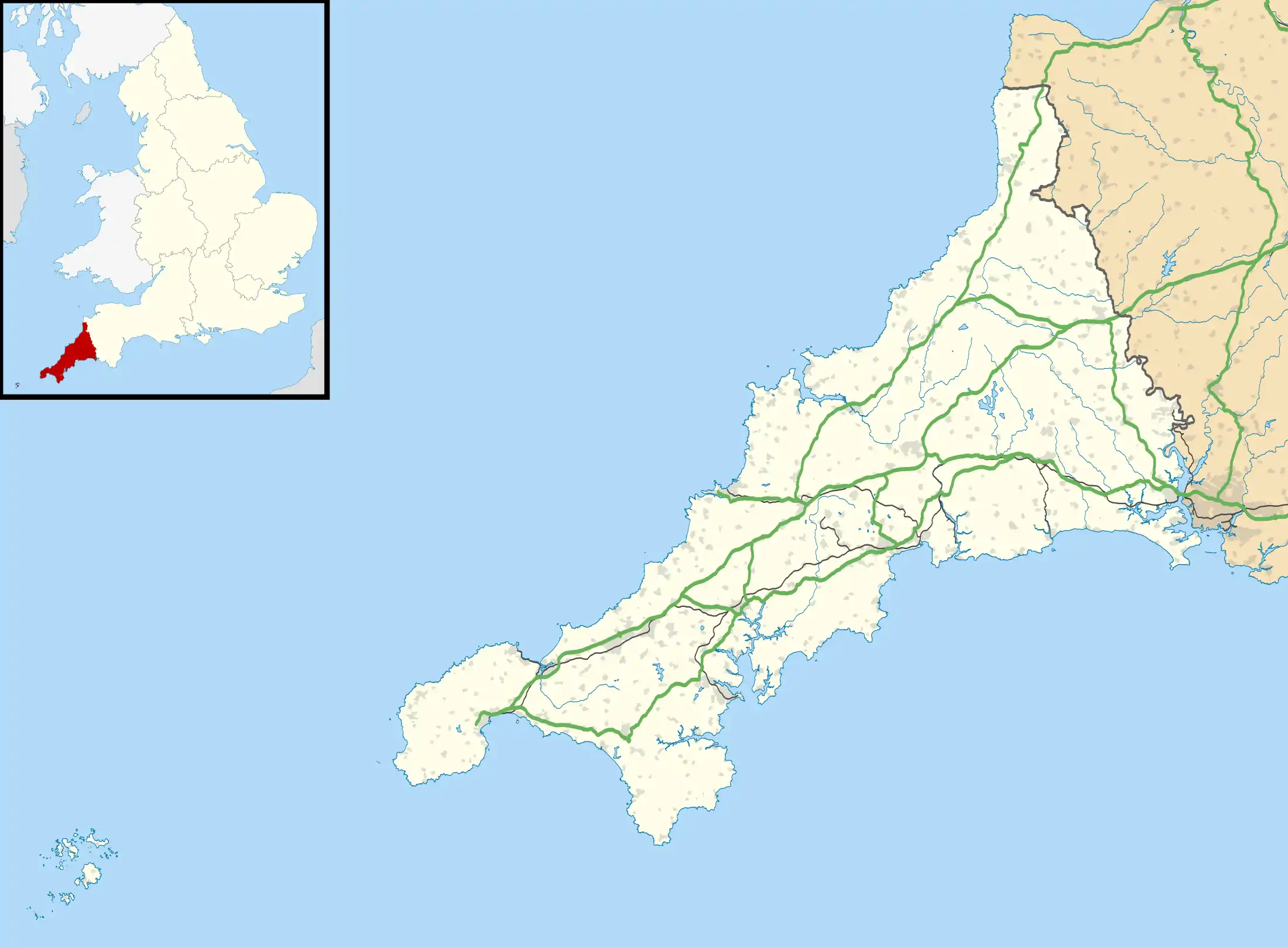Asparagus Island
Asparagus Island (Cornish: Enys Merlosowen) is a small tidal island on the eastern side of Mount's Bay, within the parish of Mullion, Cornwall, United Kingdom. It lies within Kynance Cove, a popular tourist site on the western side of The Lizard peninsula and is named after the rare wild asparagus (Asparagus prostratus) found there.[1][2]
 Seaward side of Asparagus Island | |
 Asparagus Island | |
| Geography | |
|---|---|
| Location | Mount's Bay |
| Coordinates | 49.974°N 5.233°W |
| Length | 0.24 km (0.149 mi) |
| Width | 0.1 km (0.06 mi) |
| Administration | |
England | |
| County | Cornwall |
| Demographics | |
| Population | 0 |
Geography and geology
Much of the Lizard peninsula is known for its botany and geology, and about 375 million years ago the molten rock, which eventually became the Lizard, is about 10 km (6 mi) below the surface of the earth and under immense heat and pressure. One of the rocks (peridotite), was rich in magnesium and iron, and changed through the heat and pressure to serpentinite as it pushed upwards from the Moho; the boundary of the earth's crust and mantle. It finally reached the crust's surface, about 30° south of the equator as part of an ocean ridge, in the Rheic Ocean. Over the next 80 million years the Rheic Ocean disappears and the mass of rock heads north crossing the equator about 250 million years ago. The Tropic of Cancer is reached less than 100 million years ago and the rock, which becomes the Lizard, finally reaches 50° north at about the start of the last Ice Age. The Asparagus Island rocks are tremolite serpentine, a fine-grained and banded serpentine which is different from the primary serpentine on the Lizard (bastite serpentine) because it was subject to higher pressure within the crust.[3]
The islands are here because the serpentine has been broken into blocks and invaded by other types of rock; including granite and basalt, which have been eroded by the sea.[3] The tidal island is uninhabited and is flanked by two large rocks – Gull Rock and The Bishop.[4] Before the winter storms of 2013/14 it was thought the island, which is cut off on almost every high tide, was connected to the mainland by a sand tombolo.[5] The winter storms washed the sand away to reveal a rocky ridge, probably formed more than 100,000 years ago when sea levels were higher.[6] At about half-tide a snorting can be heard – the sound of the Devil's bellows a blowhole on Asparagus Island which was caused by the sea tunnelling along a fault.[3] A second blowhole, the Post Office is so named because there is enough suction to post a letter in it![7]
Access is via the South-west coastal footpath from a nearby National Trust car park.[8]
Wildlife and ecology
Asparagus Island is within the Lizard National Nature Reserve, only the best habitats and geological formations are designated as NNRs.[9] The red data book species wild asparagus grows on the island and has been known there since the 1830s. In 1847 Gibson writes that it is in some danger of being eradicated because the (tourist) guides gather it so frequently.[10]
History
A number of microliths and other Mesolithic flints have been found and despite being reported as a flint working site, there is no evidence for this.[11]
A Danish brig the Ospra hit Asparagus Island in the early hours of Sunday, 6 May 1832. She was carrying sugar and coffee (worth £10,000), on a voyage from Havana to Hamburg. The crew, with the exception of one man who drowned, climbed onto the island and walked ashore at dawn. Both the vessel and cargo were a total loss.[12][13] The wreck became known in local legend, as the ″coffee wreck″.[14]
References
| Wikimedia Commons has media related to Asparagus Island. |
- Kent, Michael and Merryn (2008). Cornwall from the Coast Path. Penzance, Cornwall: Alison Hodge Publishers. p. 121. ISBN 978-0-906720-68-4. Retrieved 3 July 2014.
- "Wild Asparagus on Asparagus Island". Wildlife insight. Retrieved 28 December 2015.
- Bates, Robin; Scolding, Bill (2000). Beneath the Skin of The Lizard. Truro: Cornwall County Council. ISBN 1-898166-09-9.
- "Kynance Cove" (PDF). cornwallbeaches.org.uk. Cornwall's Beaches. Retrieved 3 July 2014.
- Matthews, Graham G. "Kynance Cove". helstonhistory.co.uk. Helston History. Retrieved 3 July 2014.
- "Reavealed by the storms" (PDF). Wild Cornwall (124): 10–11. Summer 2014. Archived from the original (PDF) on 18 September 2015. Retrieved 31 March 2015.
- Lawman, Jean (1994). A Natural History of the Lizard Peninsula. Redruth and Truro: Institute of Cornish Studies and Dyllansow Truran. ISBN 1-85022-071-9.
- "Lizard Point and Kynance Cove". National Trust. Retrieved 28 December 2015.
- "The Lizard National Nature Reserve: changes to site area and management". Gov.com. Natural England. Retrieved 31 August 2016.
- Gibson, G S. "Notes of some localities of plants in Cornwall etc. in the 8th month". Phytologist. 2: 676–82.
- "MONUMENT NO. 425341". Pastscape. English Heritage. Retrieved 29 November 2014.
- "FROM LLOYD'S LIST - May 8". Caledonian Mercury (17285). 12 May 1832.
- "(untitled)". The Royal Cornwall Gazette, Falmouth Packet & Plymouth Journal (1507). 12 May 1832.
- Larn, Richard; Carter, Clive (1969). Cornish Shipwrecks. The South Coast. London: Pan Books. ISBN 0-33023474-9.